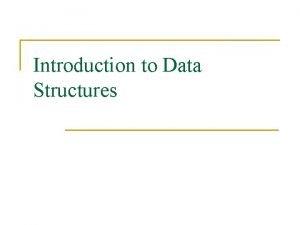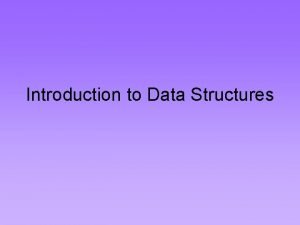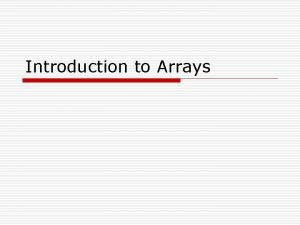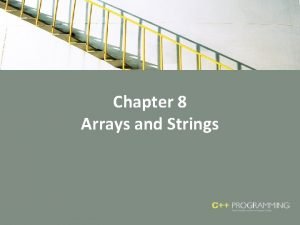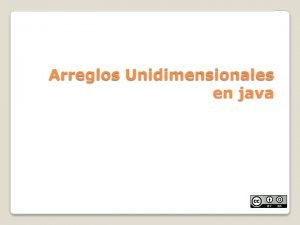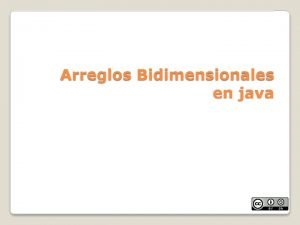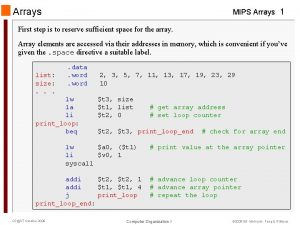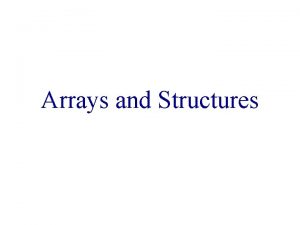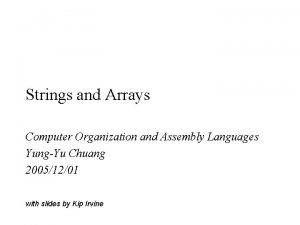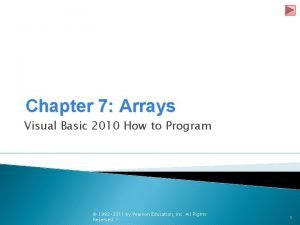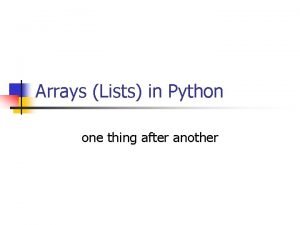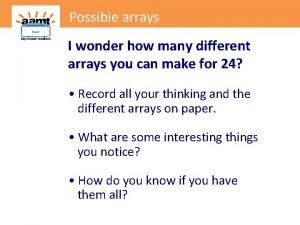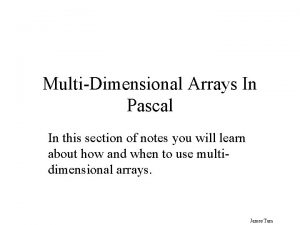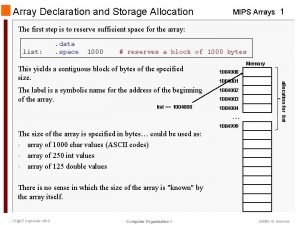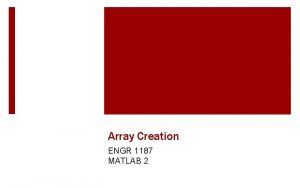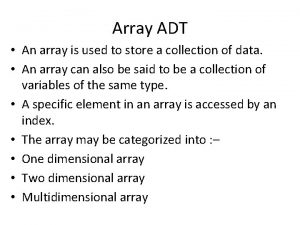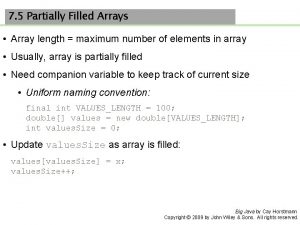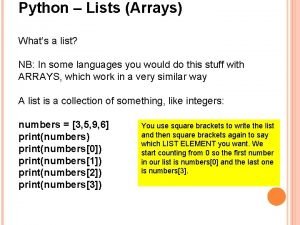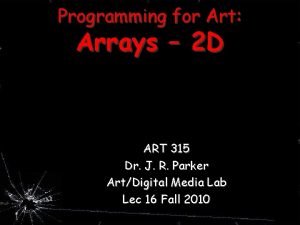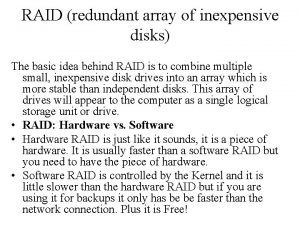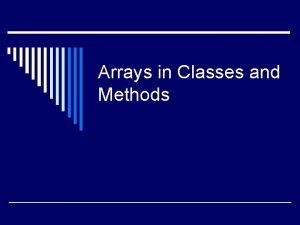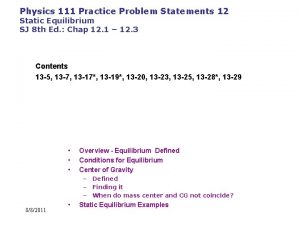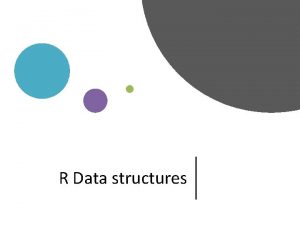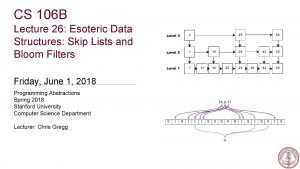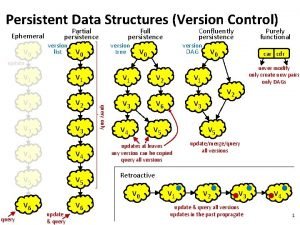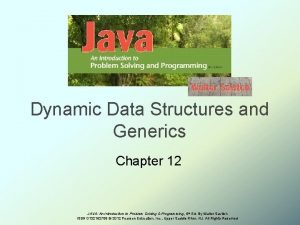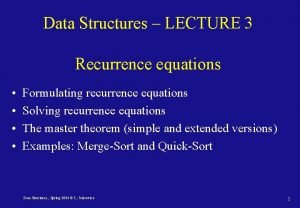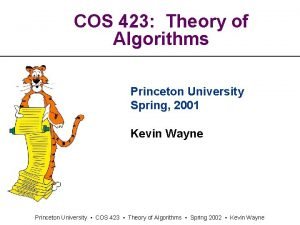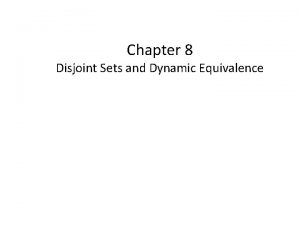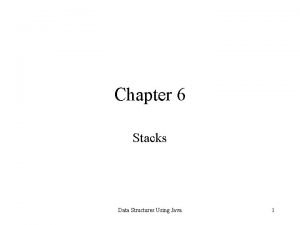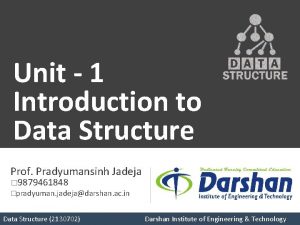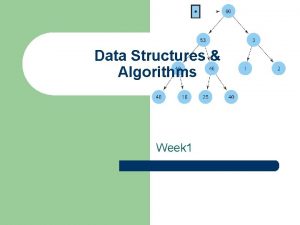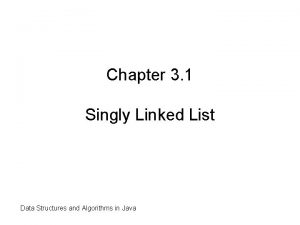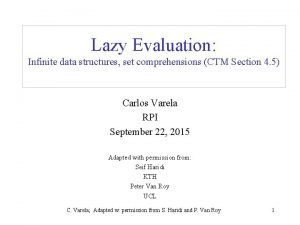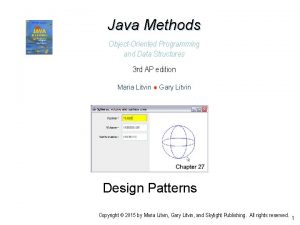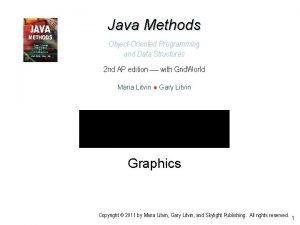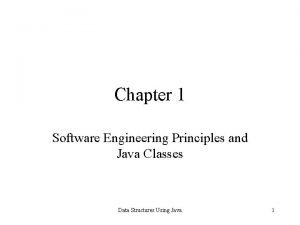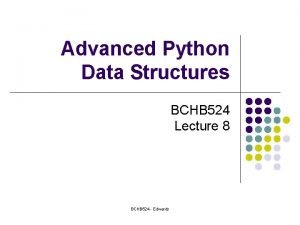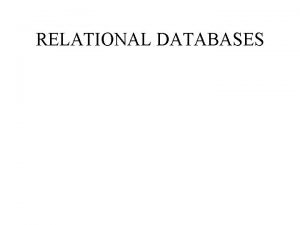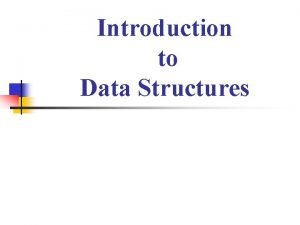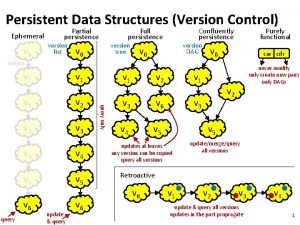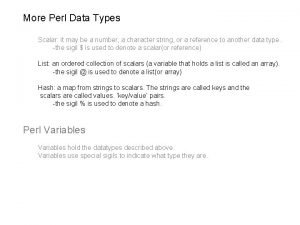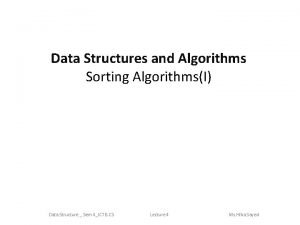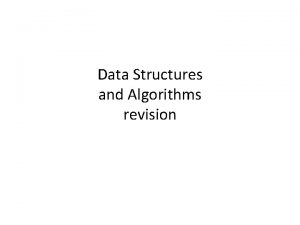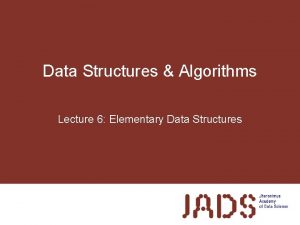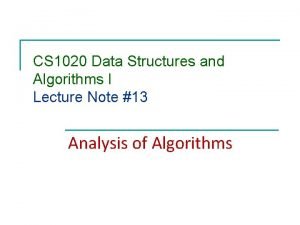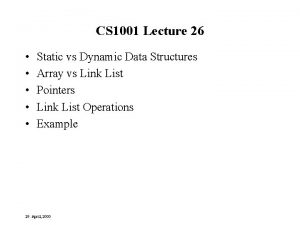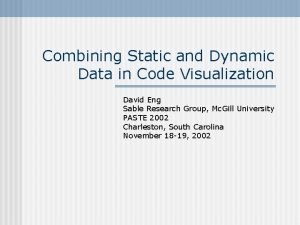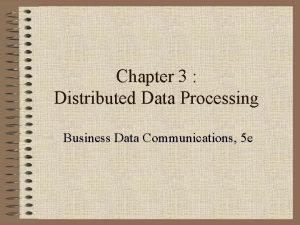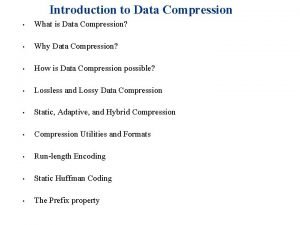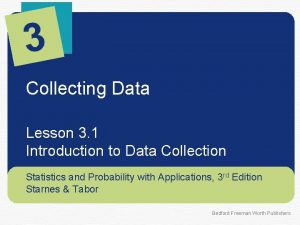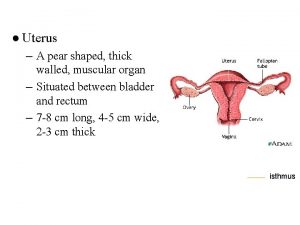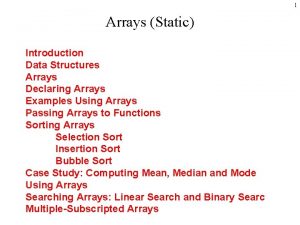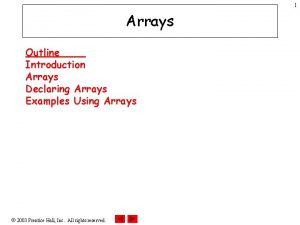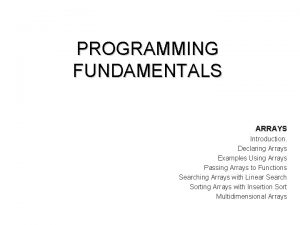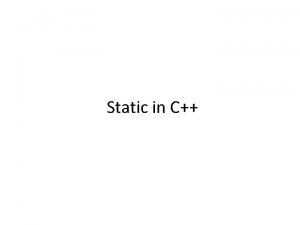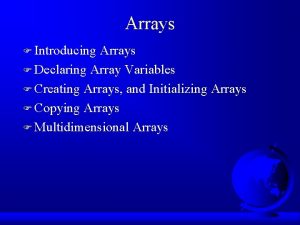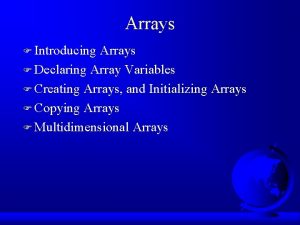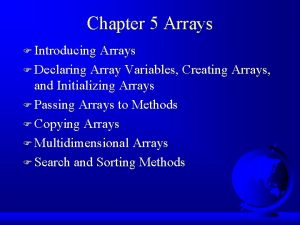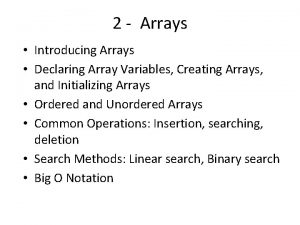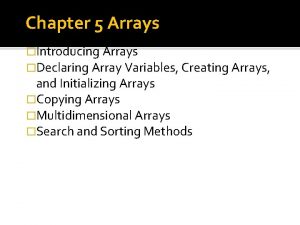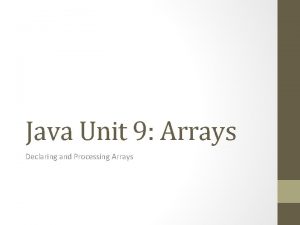1 Arrays Static Introduction Data Structures Arrays Declaring


























![27 Examples Using Arrays • Input from keyboard char string 2[ 10 ]; cin 27 Examples Using Arrays • Input from keyboard char string 2[ 10 ]; cin](https://slidetodoc.com/presentation_image_h/fc79be67e085e71e6998e85fda4990fb/image-27.jpg)















![43 Selection Sort • Start by finding the smallest entry. [0] [1] [2] [3] 43 Selection Sort • Start by finding the smallest entry. [0] [1] [2] [3]](https://slidetodoc.com/presentation_image_h/fc79be67e085e71e6998e85fda4990fb/image-43.jpg)












![Selection Sort • The code (Iterative Version): template <typename Item> void selectionsort( Item a[], Selection Sort • The code (Iterative Version): template <typename Item> void selectionsort( Item a[],](https://slidetodoc.com/presentation_image_h/fc79be67e085e71e6998e85fda4990fb/image-56.jpg)











![68 Insertion Sort · Continue shifting elements. . . [0] [1] [2] [3] [4] 68 Insertion Sort · Continue shifting elements. . . [0] [1] [2] [3] [4]](https://slidetodoc.com/presentation_image_h/fc79be67e085e71e6998e85fda4990fb/image-68.jpg)
![69 Insertion Sort · Continue shifting elements. . . [0] [1] [2] [3] [4] 69 Insertion Sort · Continue shifting elements. . . [0] [1] [2] [3] [4]](https://slidetodoc.com/presentation_image_h/fc79be67e085e71e6998e85fda4990fb/image-69.jpg)




![74 Insertion Sort • Four items are shifted. [0] [1] [2] [3] [4] [5] 74 Insertion Sort • Four items are shifted. [0] [1] [2] [3] [4] [5]](https://slidetodoc.com/presentation_image_h/fc79be67e085e71e6998e85fda4990fb/image-74.jpg)

![Insertion Sort • The code (Iterative Version): template <typename Item> void insertionsort( Item a[], Insertion Sort • The code (Iterative Version): template <typename Item> void insertionsort( Item a[],](https://slidetodoc.com/presentation_image_h/fc79be67e085e71e6998e85fda4990fb/image-76.jpg)


![79 Bubble Sort • Bubble Sort does pair-wise comparisons and swaps [0] [1] [2] 79 Bubble Sort • Bubble Sort does pair-wise comparisons and swaps [0] [1] [2]](https://slidetodoc.com/presentation_image_h/fc79be67e085e71e6998e85fda4990fb/image-79.jpg)
![80 Bubble Sort • 0 and 1 swapped Pass 1 of 6 [0] [1] 80 Bubble Sort • 0 and 1 swapped Pass 1 of 6 [0] [1]](https://slidetodoc.com/presentation_image_h/fc79be67e085e71e6998e85fda4990fb/image-80.jpg)
![81 Bubble Sort • 1 and 2 not swapped Pass 1 of 6 [0] 81 Bubble Sort • 1 and 2 not swapped Pass 1 of 6 [0]](https://slidetodoc.com/presentation_image_h/fc79be67e085e71e6998e85fda4990fb/image-81.jpg)
![82 Bubble Sort • 2 and 3 not swapped Pass 1 of 6 [0] 82 Bubble Sort • 2 and 3 not swapped Pass 1 of 6 [0]](https://slidetodoc.com/presentation_image_h/fc79be67e085e71e6998e85fda4990fb/image-82.jpg)
![83 Bubble Sort • 3 and 4 swapped Pass 1 of 6 [0] [1] 83 Bubble Sort • 3 and 4 swapped Pass 1 of 6 [0] [1]](https://slidetodoc.com/presentation_image_h/fc79be67e085e71e6998e85fda4990fb/image-83.jpg)
![84 Bubble Sort • 4 and 5 swapped Pass 1 of 6 [0] [1] 84 Bubble Sort • 4 and 5 swapped Pass 1 of 6 [0] [1]](https://slidetodoc.com/presentation_image_h/fc79be67e085e71e6998e85fda4990fb/image-84.jpg)
![85 Bubble Sort • 0 and 1 not swapped Pass 2 of 6 [0] 85 Bubble Sort • 0 and 1 not swapped Pass 2 of 6 [0]](https://slidetodoc.com/presentation_image_h/fc79be67e085e71e6998e85fda4990fb/image-85.jpg)
![86 Bubble Sort • 1 and 2 not swapped Pass 2 of 6 [0] 86 Bubble Sort • 1 and 2 not swapped Pass 2 of 6 [0]](https://slidetodoc.com/presentation_image_h/fc79be67e085e71e6998e85fda4990fb/image-86.jpg)
![87 Bubble Sort • 2 and 3 swapped Pass 2 of 6 [0] [1] 87 Bubble Sort • 2 and 3 swapped Pass 2 of 6 [0] [1]](https://slidetodoc.com/presentation_image_h/fc79be67e085e71e6998e85fda4990fb/image-87.jpg)
![88 Bubble Sort • 3 and 4 swapped Pass 2 of 6 [0] [1] 88 Bubble Sort • 3 and 4 swapped Pass 2 of 6 [0] [1]](https://slidetodoc.com/presentation_image_h/fc79be67e085e71e6998e85fda4990fb/image-88.jpg)
![89 Bubble Sort • 4 and 5 not swapped Pass 2 of 6 [0] 89 Bubble Sort • 4 and 5 not swapped Pass 2 of 6 [0]](https://slidetodoc.com/presentation_image_h/fc79be67e085e71e6998e85fda4990fb/image-89.jpg)
![90 Bubble Sort • 0 and 1 not swapped Pass 3 of 6 [0] 90 Bubble Sort • 0 and 1 not swapped Pass 3 of 6 [0]](https://slidetodoc.com/presentation_image_h/fc79be67e085e71e6998e85fda4990fb/image-90.jpg)
![91 Bubble Sort • 1 and 2 swapped Pass 3 of 6 [0] [1] 91 Bubble Sort • 1 and 2 swapped Pass 3 of 6 [0] [1]](https://slidetodoc.com/presentation_image_h/fc79be67e085e71e6998e85fda4990fb/image-91.jpg)
![92 Bubble Sort • 2 and 3 swapped Pass 3 of 6 [0] [1] 92 Bubble Sort • 2 and 3 swapped Pass 3 of 6 [0] [1]](https://slidetodoc.com/presentation_image_h/fc79be67e085e71e6998e85fda4990fb/image-92.jpg)
![93 Bubble Sort • 3 and 4 swapped Pass 3 of 6 [0] [1] 93 Bubble Sort • 3 and 4 swapped Pass 3 of 6 [0] [1]](https://slidetodoc.com/presentation_image_h/fc79be67e085e71e6998e85fda4990fb/image-93.jpg)
![94 Bubble Sort • 4 and 5 not swapped Pass 3 of 6 [0] 94 Bubble Sort • 4 and 5 not swapped Pass 3 of 6 [0]](https://slidetodoc.com/presentation_image_h/fc79be67e085e71e6998e85fda4990fb/image-94.jpg)
![95 Bubble Sort • 0 and 1 swapped Pass 4 of 6 [0] [1] 95 Bubble Sort • 0 and 1 swapped Pass 4 of 6 [0] [1]](https://slidetodoc.com/presentation_image_h/fc79be67e085e71e6998e85fda4990fb/image-95.jpg)
![96 Bubble Sort • 1 and 2 not swapped Pass 4 of 6 [0] 96 Bubble Sort • 1 and 2 not swapped Pass 4 of 6 [0]](https://slidetodoc.com/presentation_image_h/fc79be67e085e71e6998e85fda4990fb/image-96.jpg)
![97 Bubble Sort • 2 and 3 swapped Pass 4 of 6 [0] [1] 97 Bubble Sort • 2 and 3 swapped Pass 4 of 6 [0] [1]](https://slidetodoc.com/presentation_image_h/fc79be67e085e71e6998e85fda4990fb/image-97.jpg)
![98 Bubble Sort • 3 and 4 not swapped Pass 4 of 6 [0] 98 Bubble Sort • 3 and 4 not swapped Pass 4 of 6 [0]](https://slidetodoc.com/presentation_image_h/fc79be67e085e71e6998e85fda4990fb/image-98.jpg)
![99 Bubble Sort • 4 and 5 not swapped Pass 4 of 6 [0] 99 Bubble Sort • 4 and 5 not swapped Pass 4 of 6 [0]](https://slidetodoc.com/presentation_image_h/fc79be67e085e71e6998e85fda4990fb/image-99.jpg)
![100 Bubble Sort • 0 and 1 not swapped Pass 5 of 6 [0] 100 Bubble Sort • 0 and 1 not swapped Pass 5 of 6 [0]](https://slidetodoc.com/presentation_image_h/fc79be67e085e71e6998e85fda4990fb/image-100.jpg)





![Bubble Sort • The code (Iterative Version): template <typename Item> void bubblesort( Item a[], Bubble Sort • The code (Iterative Version): template <typename Item> void bubblesort( Item a[],](https://slidetodoc.com/presentation_image_h/fc79be67e085e71e6998e85fda4990fb/image-106.jpg)





![int frequency[ 10 ] = { 0 }; // initialize array frequency // int frequency[ 10 ] = { 0 }; // initialize array frequency //](https://slidetodoc.com/presentation_image_h/fc79be67e085e71e6998e85fda4990fb/image-112.jpg)
![// calculate average of all response values void mean( const int answer[], int array. // calculate average of all response values void mean( const int answer[], int array.](https://slidetodoc.com/presentation_image_h/fc79be67e085e71e6998e85fda4990fb/image-113.jpg)
![// sort array and determine median element's value void median( int answer[], int size // sort array and determine median element's value void median( int answer[], int size](https://slidetodoc.com/presentation_image_h/fc79be67e085e71e6998e85fda4990fb/image-114.jpg)
![// determine most frequent response void mode( int freq[], int answer[], int size ) // determine most frequent response void mode( int freq[], int answer[], int size )](https://slidetodoc.com/presentation_image_h/fc79be67e085e71e6998e85fda4990fb/image-115.jpg)


![// output array contents (20 values per row) void print. Array( const int a[], // output array contents (20 values per row) void print. Array( const int a[],](https://slidetodoc.com/presentation_image_h/fc79be67e085e71e6998e85fda4990fb/image-118.jpg)















![Multiple-Subscripted Arrays (Multi-dimensional Arrays) • Multiple subscripts – – a[ i ][ j ] Multiple-Subscripted Arrays (Multi-dimensional Arrays) • Multiple subscripts – – a[ i ][ j ]](https://slidetodoc.com/presentation_image_h/fc79be67e085e71e6998e85fda4990fb/image-134.jpg)

![136 Multiple-Subscripted Arrays • Referenced like normal cout << b[ 0 ][ 1 ]; 136 Multiple-Subscripted Arrays • Referenced like normal cout << b[ 0 ][ 1 ];](https://slidetodoc.com/presentation_image_h/fc79be67e085e71e6998e85fda4990fb/image-136.jpg)






![70 71 72 73 74 // find maximum grade int maximum( int grades[][ exams 70 71 72 73 74 // find maximum grade int maximum( int grades[][ exams](https://slidetodoc.com/presentation_image_h/fc79be67e085e71e6998e85fda4990fb/image-143.jpg)


![The array is: [0] [1] [2] [3] student. Grades[0] 77 68 86 73 student. The array is: [0] [1] [2] [3] student. Grades[0] 77 68 86 73 student.](https://slidetodoc.com/presentation_image_h/fc79be67e085e71e6998e85fda4990fb/image-146.jpg)
- Slides: 146

1 Arrays (Static) Introduction Data Structures Arrays Declaring Arrays Examples Using Arrays Passing Arrays to Functions Sorting Arrays Selection Sort Insertion Sort Bubble Sort Case Study: Computing Mean, Median and Mode Using Arrays Searching Arrays: Linear Search and Binary Searc Multiple-Subscripted Arrays

2 Data Structures • Algorithms vs. Data Structures – Algorithms tell the computer how to do something – Data Structures are ways to store information so that certain algorithms can be used on that data – e. g. Arrays, Linked-Lists, Stacks, Queues, Binary-Search Trees, Red-Black Trees, etc. • Data Structures always have two parts: – The data organization – Operators (the algorithms defined for that data)

Data Structures Stacks example: - Free to organize the data anyway you want so long as the order in which the items were put into the stack is preserved, so that the last thing added to the list can be retrieved first (LIFO – Last-in-First-Out). - There are only two operations: - “Push” which means put something on the top of the stack - “Pop” which means get (and remove) whatever is on top of the stack 3

• • • Data Structures - Arrays An array is also a Data Structure (the most primitive one): The data is organized contiguously in memory. The operations are “assign” and “read” (just like with variables). We read the value of an element in an array like this Array[i]. We assign a value to an element in an array like this: – Array[i] = 3; where Array is the name of the array, i is the index of the element in the array we want to assign a value to and 3 is the value we are putting in position i of the array 4

5 Arrays • Array – Consecutive group of memory locations – Same name and type (int, char, etc. ) • To refer to an element – Specify array name and position number (index) – Format: arrayname[ position number ] – First element is at position 0 • N-element array c c[ 0 ], c[ 1 ] … c[ n - 1 ] – Nth element as position N-1

6 Arrays Name of array (Note that all elements of this array When we declared a variable we reserved a single location in memory and gave it a label (e. g int x) With an array we reserve many adjacent memory locations and give them a single label have the same name, c) c[0] -45 c[1] 6 c[2] 0 c[3] 72 c[4] 1543 c[5] -89 c[6] 0 c[7] 62 c[8] -3 c[9] 1 c[10] 6453 c[11] 78 Position number of the element within array c

7 Arrays • Array elements act like other variables – Assignment, printing for an integer array c c[ 0 ] = 3; cout << c[ 0 ]; • Can perform operations inside subscript c[ 5 – 2 ] same as c[3] • The [] operator returns a specific memory location within the array. • [5] counts memory locations (starting at the 0 th one) and returns the value in the 6 th memory location from the start of the array.

8 Declaring Arrays • When declaring arrays, specify – Name – Type of array • Any data type – Number of elements – type array. Name[ array. Size ]; int c[ 10 ]; // array of 10 integers float d[ 3284 ]; // array of 3284 floats • Declaring multiple arrays of same type – Use comma separated list, like regular variables int b[ 100 ], x[ 27 ];

Initializing Arrays • Initializing arrays – For loop • Set each element individually – Initializer list • Specify each element when array declared int n[ 5 ] = { 1, 2, 3, 4, 5 }; • If not enough initializers, rightmost elements 0 • If too many syntax error – To set every element to same value int n[ 5 ] = { 0 }; – If array size omitted, initializers determine size int n[] = { 1, 2, 3, 4, 5 }; • 5 initializers, therefore 5 element array 9

// Initializing an array. #include <iostream> Declare a 10 -element array of integers. using namespace std; Initialize array to 0 int main() { using a for loop. int n[ 10 ]; // n is an array of 10 integers Note that the array has elements n[0] // initialize elements of array n to 0 to n[9]. for ( int i = 0; i < 10; i++ ) n[ i ] = 0; // set element at location i to 0 cout << "Elementt. Value" << endl; // output contents of array n in tabular format for ( int j = 0; j < 10; j++ ) cout << j << “t” << n[ j ] << endl; return 0; }

The program prints: Element Value 0 0 1 0 2 0 3 0 4 0 5 0 6 0 7 0 8 0 9 0

// Initializing an array with a declaration. #include <iostream> using namespace std; fig 04_04. c Note the use of the pp initializer list. (1 of 1) int main() { // use initializer list to initialize array n int n[ 10 ] = { 32, 27, 64, 18, 95, 14, 90, 70, 60, 37 }; cout << "Elementt. Value" << endl; // output contents of array n in tabular format for ( int i = 0; i < 10; i++ ) cout << i << “t” << n[ i ] << endl; return 0; // indicates successful execution } // end main

Element Value 0 32 1 27 2 64 3 18 4 95 5 14 6 90 7 70 8 60 9 37

Tip: use constants to keep track of array sizes • Array size – Since the size of an array cannot change once it has been declared use a constant to keep track of that size (why? ) – Can be specified with constant variable (const) • const int size = 20; – Constants cannot be changed – Constants must be initialized when declared – Also called named constants or read-only variables 14

// Using a properly initialized constant variable. Proper initialization of #include <iostream> int main() const variable. { const int x = 7; // initialized constant variable cout << "The value of constant variable x is: " << x << endl; return 0; // indicates successful termination } // end main The value of constant variable x is: 7 // Mistakes using const int main() { const int x; // Error: x must be initialized x = 7; // Error: cannot modify a const variable return 0; // indicates successful termination } // end main fig 04_06. c pp (1 of 1) fig 04_06. c pp Uninitialized const output (1 results in a syntax error. of 1) Attempting to modify the const is another error. Can only assign a value when the const variable is declared. d: cpphtp 4_examplesch 04Fig 04_07. cpp(6) : error C 2734: 'x' : const object must be initialized if not extern d: cpphtp 4_examplesch 04Fig 04_07. cpp(8) : error C 2166:

// Initialize array s to the even integers from 2 to 20. #include <iostream> using namespace std; Note use of const keyword. Only const fig 04_05. c variables can specify pp array sizes. int main() { // constant variable can be used to specify array size const int array. Size = 10; int s[ array. Size ]; // array s has 10 elements for ( int i = 0; i < array. Size; i++ ) // set the values s[ i ] = 2 + 2 * i; (1 of 2) The program becomes more scalable when we set the cout << "Elementt. Value" << endl; array size using a const // output contents of array s in tabular format variable. We can change for ( int j = 0; j < array. Size; j++ ) array. Size, and all the { loops will still work cout << j << “t” << s[ j ] << endl; } (otherwise, we’d have to update every loop in the return 0; // indicates successful termination program). } // end main

The previous program prints: Element Value 0 2 1 4 2 6 3 8 4 10 5 12 6 14 7 16 8 18 9 20

// Compute the sum of the elements of the array. #include <iostream> using namespace std; fig 04_08. c pp (1 of 1) int main() { const int array. Size = 10; int a[ array. Size ] = { 1, 2, 3, 4, 5, 6, 7, 8, 9, 10 }; int total = 0; fig 04_08. c pp output (1 of 1) // sum contents of array a for ( int i = 0; i < array. Size; i++ ) { total += a[ i ]; } cout << "Total of array element values is " << total << endl; return 0; // indicates successful termination } // end main Total of array element values is 55

// Histogram printing program. #include <iostream> using namespace std; int main() { const int array. Size = 10; int n[ array. Size ] = { 19, 3, 15, 7, 11, 9, 13, 5, 17, 1 }; cout << "Elementt. Valuet. Histogram" << endl; // for each element of array n, output a bar in the histogram for ( int i = 0; i < array. Size; i++ ) { cout << i << “t” << n[ i ] << “t”; for ( int j = 0; j < n[ i ]; j++ ) // print one bar { Prints the number of cout << '*'; asterisks corresponding } to the value in array cout << endl; element, n[i]. }

The previous program prints: Element Value Histogram 0 19 ********** 1 3 *** 2 15 ******** 3 7 ******* 4 11 ****** 5 9 ***** 6 13 ******* 7 5 ***** 8 17 ********* 9 1 *

// Roll a six-sided die 6000 times. #include <iostream> // For I/O #include <cstdlib> // For rand function #include <ctime> // For time function Remake of old program to roll dice from your book. An array is used fig 04_10. c instead of 6 regular pp int main() variables, and the { proper element can be (1 of 2) const int array. Size = 7; updated easily (without int frequency[ array. Size ] = { 0 }; needing a selection srand( time( 0 ) ); // seed random-number generator structure). for ( int roll = 1; roll <= 6000; roll++ ) //roll 6000 times This creates a number { between 1 and 6, which ++frequency[ 1 + rand() % 6 ]; // replaces 20 -line switch determines the index of } frequency[] that // output frequency elements 1 -6 in tabular format should be incremented. cout << "Facet. Frequency" << endl; for ( int face = 1; face < array. Size; face++ ) { cout << face << “t” << frequency[ face ] << endl; } return 0; // indicates successful program execution } // end main

Output from previous program: Face Frequency 1 1003 2 1004 3 999 4 980 5 1013 6 1001

// Student poll program. #include <iostream> using namespace std; fig 04_11. c pp (1 of 2) int main() { // define array sizes const int response. Size = 40; // size of array responses const int frequency. Size = 11; // size of array frequency // place survey responses in array responses int responses[ response. Size ] = { 1, 2, 6, 4, 8, 5, 9, 7, 8, 10, 1, 6, 3, 8, 6, 10, 3, 8, 2, 7, 6, 5, 7, 6, 8, 6, 7, 5, 6, 6, 5, 6, 7, 5, 6, 4, 8, 6, 8, 10 }; // initialize frequency counters to 0 int frequency[ frequency. Size ] = { 0 };

// for each answer, select value of an element of array // responses and use that value as subscript in array // frequency to determine element to increment for ( int answer = 0; answer < response. Size; answer++ ) { ++(frequency[ responses[answer] ]); } // display results cout << "Ratingt. Frequency" << endl; // output frequencies in tabular format for ( int rating = 1; rating < frequency. Size; rating++ ) { responses[answer cout << rating << frequency[ rating ] << endl; ] is the rating (from 1 } to 10). This determines the index in return 0; // indicates successful termination frequency[] to } // end main increment.

Rating Frequency 1 2 2 2 3 2 4 2 5 5 6 11 7 5 8 7 9 1 10 3

Character Arrays (strings) • Strings – Arrays of characters – All strings end with the null character, '�' – Examples • char string 1[] = "hello"; – Null character implicitly added -string 1 has 6 elements - char string 1[]={'h', 'e', 'l', 'o', '�’}; – Subscripting is the same String 1[ 0 ] is 'h' string 1[ 2 ] is 'l' 26
![27 Examples Using Arrays Input from keyboard char string 2 10 cin 27 Examples Using Arrays • Input from keyboard char string 2[ 10 ]; cin](https://slidetodoc.com/presentation_image_h/fc79be67e085e71e6998e85fda4990fb/image-27.jpg)
27 Examples Using Arrays • Input from keyboard char string 2[ 10 ]; cin >> string 2; – Puts user input in string • Stops at first whitespace character • Adds null character – If too much text entered, data written beyond array • We want to avoid this (section 5. 12 explains how) • Printing strings – cout << string 2 << endl; • Does not work for other array types – Characters printed until null found

// Treating character arrays as strings. #include <iostream> using namespace std; Two different ways to declare strings. string 2 is initialized, and its size determined automatically. int main() { char string 1[ 20 ], // reserves 20 characters char string 2[] = "string literal"; // reserves 15 characters // read string from user into array string 2 cout << "Enter the string "hello there": " ; cin >> string 1; // reads "hello" [space terminates input] Examples of reading strings from the keyboard and printing them out. // output strings cout << "string 1 is: " << string 1 << "nstring 2 is: " << string 2; cout << "nstring 1 with spaces between characters is: n" ; // output characters until null character is reached for ( int i = 0; string 1[ i ] != '�'; i++ ) { cout << string 1[ i ] << ' '; } cin >> string 1; // reads "there" cout << "nstring 1 is: " << string 1 << endl; return 0; // indicates successful termination } // end main fig 04_12. c pp (1 of 2)

Enter the string "hello there": hello there string 1 is: hello string 2 is: string literal string 1 with spaces between characters is: h e l l o string 1 is: there

Passing Arrays to Functions • Specify name without brackets – To pass array my. Array to my. Function int my. Array[ 24 ]; my. Function(my. Array, 24); – Array size usually passed, but not required • Useful to iterate over all elements 30

31 Passing Arrays to Functions • Arrays passed-by-reference – Functions can modify original array data – Value of name of array is address of first element • Function knows where the array is stored • Can change original memory locations • Individual array elements passed-by-value – Like regular variables – square( my. Array[3] );

32 Passing Arrays to Functions • Functions taking arrays – Function prototype • void modify. Array( int b[], int array. Size ); • void modify. Array( int [], int ); – Names optional in prototype • Both take an integer array and a single integer – No need for array size between brackets • Ignored by compiler – If declare array parameter as const • Cannot be modified (compiler error) • void do. Not. Modify( const int [] );

// Passing arrays and individual array elements to functions. #include <iostream> Syntax for accepting an array in parameter list. fig 04_14. c pp void modify. Array( int [], int ); // appears strange (1 of 3) using namespace std; void modify. Element( int ); int main() { const int array. Size = 5; // size of array a int a[ array. Size ] = { 0, 1, 2, 3, 4 }; // initialize a cout << "Effects of passing entire array by reference: " << "nn. The values of the original array are: n"; // output original array for ( int i = 0; i < array. Size; i++ ) cout << “t” << a[ i ];

Pass array name (a) and size to function. Arrays // pass array a to modify. Array by reference are passed-by-reference. modify. Array( a, array. Size ); cout << endl; cout << "The values of the modified array are: n"; // output modified array for ( int j = 0; j < array. Size; j++ ) cout << setw( 3 ) << a[ j ]; // output value of a[ 3 ] cout << "nnn" << "Effects of passing array element by value: " << "nn. The value of a[3] is " << a[ 3 ] << 'n'; Pass a single array element by value; // pass array element a[ 3 ] by value modify. Element( a[ 3 ] ); the original cannot be modified. // output value of a[ 3 ] cout << "The value of a[3] is " << a[ 3 ] << endl; return 0; // indicates successful termination } // end main

// in function modify. Array, "b" points to Although named b, // the original array "a" in memory the array points to void modify. Array( int b[], int size. Of. Array ) the original array a. fig 04_14. c { It can modify a’s pp // multiply each array element by 2 data. for ( int k = 0; k < size. Of. Array; k++ ) (3 of 3) b[ k ] *= 2; } // end function modify. Array Individual array // in function modify. Element, "e" is a local copy of elements are passed by // array element a[ 3 ] passed from main value, and the originals void modify. Element( int e ) cannot be changed. { // multiply parameter by 2 cout << "Value in modify. Element is " << ( e *= 2 ) << endl; } // end function modify. Element

Effects of passing entire array by reference: The values of the original array are: 0 1 2 3 4 The values of the modified array are: 0 2 4 6 8 Effects of passing array element by value: The value of a[3] is 6 Value in modify. Element is 12 The value of a[3] is 6

// Demonstrating the const type qualifier. #include <iostream> fig 04_15. c pp void try. To. Modify. Array( const int [] ); // function (1 of 2) prototype using namespace std; int main() { int a[] = { 10, 20, 30 }; Array parameter declared as const. Array cannot be try. To. Modify. Array( a ); modified, even though it is passed by reference. cout << a[ 0 ] << ' ' << a[ 1 ] << ' ' << a[ 2 ] << 'n'; return 0; // indicates successful termination } // end main

// In function try. To. Modify. Array, "b" cannot be used // to modify the original array "a" in main. void try. To. Modify. Array( const int b[] ) { b[ 0 ] /= 2; // error b[ 1 ] /= 2; // error b[ 2 ] /= 2; // error } // end function try. To. Modify. Array d: cpphtp 4_examplesch 04Fig 04_15. cpp(26) : error C 2166: l-value specifies const object d: cpphtp 4_examplesch 04Fig 04_15. cpp(27) : error C 2166: l-value specifies const object d: cpphtp 4_examplesch 04Fig 04_15. cpp(28) : error C 2166: l-value specifies const object

Comparing Algorithms • When choosing a particular algorithm there are three things to consider: 1) How easy is the algorithm to understand implement? 2) How fast is the algorithm? 3) How much memory does the algorithm use? • • • Implementing an algorithm because it is easy to write and debug, even if it is slow is often the right choice. We can sometimes trade time (execution time) for space (memory) and vice versa. Whether time is more important than space depends on the particular problem you have. 39

40 Sorting Arrays • Sorting data • Definition of a sorting: – Given an array of values [a 1, a 2, a 3, a 4, …, an] produce a permutation of that array such that: [a 1 ≤ a 2 ≤ a 3 ≤ a 4 … ≤ an]. – Important computing application – Virtually every organization must sort some data • Massive amounts must be sorted

Selection Sort • Think of the array as being split into two – the sorted part and the unsorted part. (the sorted array initially has zero elements) – Find the smallest element i of the unsorted part. – Swap i with the element at the end of the sorted part of the array. – This increases the size of the sorted portion by one element and decreases the size of the unsorted array. – When the unsorted part has size zero and the sorted part has all the elements we are done. 41

42 Selection Sort • The picture shows an array of six integers that we want to sort from smallest to largest [0] [1] [2] [3] [4] [5]
![43 Selection Sort Start by finding the smallest entry 0 1 2 3 43 Selection Sort • Start by finding the smallest entry. [0] [1] [2] [3]](https://slidetodoc.com/presentation_image_h/fc79be67e085e71e6998e85fda4990fb/image-43.jpg)
43 Selection Sort • Start by finding the smallest entry. [0] [1] [2] [3] [4] [5]

44 Selection Sort • Start by finding the smallest entry. • Swap the smallest entry with the first entry. [0] [1] [2] [3] [4] [5]

45 Selection Sort • Start by finding the smallest entry. • Swap the smallest entry with the first entry. [0] [1] [2] [3] [4] [5]

46 Selection Sorted side Unsorted side • Part of the array is now sorted. [0] [1] [2] [3] [4] [5]

47 Selection Sorted side Unsorted side • Find the smallest element in the unsorted side. [0] [1] [2] [3] [4] [5]

48 Selection Sorted side • Find the smallest element in the unsorted side. • Swap with the front of the unsorted side. [0] Unsorted side [1] [2] [3] [4] [5]

49 Selection Sort • We have increased the size of the sorted side by one element. Sorted side [0] [1] Unsorted side [2] [3] [4] [5]

50 Selection Sort • The process continues. . . Sorted side Unsorted side Smallest from unsorted [0] [1] [2] [3] [4] [5]

51 Selection Sort • The process continues. . . Sorted side Unsorted side ap w S th wi t n fro [0] [1] [2] [3] [4] [5]

52 Selection Sorted side is bigger Sorted side Unsorted side • The process continues. . . [0] [1] [2] [3] [4] [5]

53 Selection Sort • The process keeps adding one more number to the sorted side. • The sorted side has the smallest numbers, arranged from small to large. Sorted side [0] [1] [2] [3] Unsorted side [4] [5]

54 Selection Sort • We can stop when the unsorted side has just one number, since that number must be the largest number. Sorted side [0] [1] [2] [3] [4] Unsorted sid [5]

55 Selection Sort • The array is now sorted. • We repeatedly selected the smallest element, and moved this element to the front of the unsorted side. [0] [1] [2] [3] [4] [5]
![Selection Sort The code Iterative Version template typename Item void selectionsort Item a Selection Sort • The code (Iterative Version): template <typename Item> void selectionsort( Item a[],](https://slidetodoc.com/presentation_image_h/fc79be67e085e71e6998e85fda4990fb/image-56.jpg)
Selection Sort • The code (Iterative Version): template <typename Item> void selectionsort( Item a[], int left, int right) { for ( int i = left; i < right; i++ ) { int min = i; for ( int j = i + 1; j < = right; j++ ) { if ( a[j] < a[min]) { min = j; } swap( a[j], a[min] ); } } } 56

57 Sorting Algorithms • Insertion Sort (Iterative Version) • Outer Loop – In turn take each element i of the input array input_array to be sorted and insert it into a new array sorted_array (or if we are clever the same array). • Inner Loop – Iterate through sorted_array until an element smaller than i is found. Put

58 Insertion Sort • The Insertionsort algorithm also views the array as having a sorted side and an unsorted side. [0] [1] [2] [3] [4] [5]

59 Insertion Sorted side Unsorted side • The sorted side starts with just the first element, which is not necessarily the smallest element. [0] [1] [2] [3] [4] [5]

60 Insertion Sorted side Unsorted side • The sorted side grows by taking the front element from the unsorted side. . . [0] [1] [2] [3] [4] [5]

61 Insertion Sorted side Unsorted side • . . . and inserting it in the place that keeps the sorted side arranged from small to large. [0] [1] [2] [3] [4] [5]

62 Insertion Sorted side Unsorted side • In this example, the new element goes in front of the element that was already in the sorted side. [0] [1] [2] [3] [4] [5]

63 Insertion Sorted side Unsorted side • Sometimes we are lucky and the new inserted item doesn't need to move at all. [0] [1] [2] [3] [4] [5]

64 Insertion Sorted side Unsorted side • Sometimes we are lucky twice in a row. [0] [1] [2] [3] [4] [5]

65 Insertion Sort ¶ Copy the new element to a separate location. Sorted side [0] [1] [2] [3] Unsorted side [4] [5]

66 Insertion Sort · Shift elements in the sorted side, creating an open space for the new element. [0] [1] [2] [3] [4] [5]

67 Insertion Sort · Shift elements in the sorted side, creating an open space for the new element. [0] [1] [2] [3] [4] [5]
![68 Insertion Sort Continue shifting elements 0 1 2 3 4 68 Insertion Sort · Continue shifting elements. . . [0] [1] [2] [3] [4]](https://slidetodoc.com/presentation_image_h/fc79be67e085e71e6998e85fda4990fb/image-68.jpg)
68 Insertion Sort · Continue shifting elements. . . [0] [1] [2] [3] [4] [5]
![69 Insertion Sort Continue shifting elements 0 1 2 3 4 69 Insertion Sort · Continue shifting elements. . . [0] [1] [2] [3] [4]](https://slidetodoc.com/presentation_image_h/fc79be67e085e71e6998e85fda4990fb/image-69.jpg)
69 Insertion Sort · Continue shifting elements. . . [0] [1] [2] [3] [4] [5]

70 Insertion Sort ·. . . until you reach the location for the new element. [0] [1] [2] [3] [4] [5]

71 Insertion Sort ¸ Copy the new element back into the array, at the correct location. Sorted side [0] [1] [2] [3] [4] Unsorted side [5]

72 Insertion Sort • The last element must also be inserted. Start by copying it. . . Sorted side [0] [1] [2] [3] [4] Unsorted side [5]

73 Insertion Sort How many shifts will occur before we copy this element back into the array? [0] [1] [2] [3] [4] [5]
![74 Insertion Sort Four items are shifted 0 1 2 3 4 5 74 Insertion Sort • Four items are shifted. [0] [1] [2] [3] [4] [5]](https://slidetodoc.com/presentation_image_h/fc79be67e085e71e6998e85fda4990fb/image-74.jpg)
74 Insertion Sort • Four items are shifted. [0] [1] [2] [3] [4] [5]

75 Insertion Sort • Four items are shifted. • And then the element is copied back into the array. [0] [1] [2] [3] [4] [5]
![Insertion Sort The code Iterative Version template typename Item void insertionsort Item a Insertion Sort • The code (Iterative Version): template <typename Item> void insertionsort( Item a[],](https://slidetodoc.com/presentation_image_h/fc79be67e085e71e6998e85fda4990fb/image-76.jpg)
Insertion Sort • The code (Iterative Version): template <typename Item> void insertionsort( Item a[], int left, int right) { int i, j, index; for (i=1; i < array_size; i++) { index = numbers[i]; j = i; while ((j > 0) && (numbers[j-1] > index)) { numbers[j] = numbers[j-1]; j = j - 1; } numbers[j] = index; } } } 76

Insertion Sort Here is a more efficient version (nearly twice as fast, but harder to understand) template <typename Item> void insertionsort( Item a[], int left, int right) { for ( int i = right; i > left; i-- ) { if ( a[i-1] < a[i]) { swap( a[i-1], a[i]); } } for ( int i = left + 2; i <= right; i++ ) { int j = i; Item v = a[i]; while( v < a[j-1]) { a[j] = a[j-1]; j--; } a[j] = v; } } 77

78 Sorting Algorithms • Bubble Sort (Iterative Version) • Outer Loop Performs the inner loop n times, where n is the size of the array. This guarantees that even an element which is at completely the wrong end of the array will end up in the right place. • Inner Loop Compares adjacent elements and swaps them if they are out of order.
![79 Bubble Sort Bubble Sort does pairwise comparisons and swaps 0 1 2 79 Bubble Sort • Bubble Sort does pair-wise comparisons and swaps [0] [1] [2]](https://slidetodoc.com/presentation_image_h/fc79be67e085e71e6998e85fda4990fb/image-79.jpg)
79 Bubble Sort • Bubble Sort does pair-wise comparisons and swaps [0] [1] [2] [3] [4] [5]
![80 Bubble Sort 0 and 1 swapped Pass 1 of 6 0 1 80 Bubble Sort • 0 and 1 swapped Pass 1 of 6 [0] [1]](https://slidetodoc.com/presentation_image_h/fc79be67e085e71e6998e85fda4990fb/image-80.jpg)
80 Bubble Sort • 0 and 1 swapped Pass 1 of 6 [0] [1] [2] [3] [4] [5]
![81 Bubble Sort 1 and 2 not swapped Pass 1 of 6 0 81 Bubble Sort • 1 and 2 not swapped Pass 1 of 6 [0]](https://slidetodoc.com/presentation_image_h/fc79be67e085e71e6998e85fda4990fb/image-81.jpg)
81 Bubble Sort • 1 and 2 not swapped Pass 1 of 6 [0] [1] [2] [3] [4] [5]
![82 Bubble Sort 2 and 3 not swapped Pass 1 of 6 0 82 Bubble Sort • 2 and 3 not swapped Pass 1 of 6 [0]](https://slidetodoc.com/presentation_image_h/fc79be67e085e71e6998e85fda4990fb/image-82.jpg)
82 Bubble Sort • 2 and 3 not swapped Pass 1 of 6 [0] [1] [2] [3] [4] [5]
![83 Bubble Sort 3 and 4 swapped Pass 1 of 6 0 1 83 Bubble Sort • 3 and 4 swapped Pass 1 of 6 [0] [1]](https://slidetodoc.com/presentation_image_h/fc79be67e085e71e6998e85fda4990fb/image-83.jpg)
83 Bubble Sort • 3 and 4 swapped Pass 1 of 6 [0] [1] [2] [3] [4] [5]
![84 Bubble Sort 4 and 5 swapped Pass 1 of 6 0 1 84 Bubble Sort • 4 and 5 swapped Pass 1 of 6 [0] [1]](https://slidetodoc.com/presentation_image_h/fc79be67e085e71e6998e85fda4990fb/image-84.jpg)
84 Bubble Sort • 4 and 5 swapped Pass 1 of 6 [0] [1] [2] [3] [4] [5]
![85 Bubble Sort 0 and 1 not swapped Pass 2 of 6 0 85 Bubble Sort • 0 and 1 not swapped Pass 2 of 6 [0]](https://slidetodoc.com/presentation_image_h/fc79be67e085e71e6998e85fda4990fb/image-85.jpg)
85 Bubble Sort • 0 and 1 not swapped Pass 2 of 6 [0] [1] [2] [3] [4] [5]
![86 Bubble Sort 1 and 2 not swapped Pass 2 of 6 0 86 Bubble Sort • 1 and 2 not swapped Pass 2 of 6 [0]](https://slidetodoc.com/presentation_image_h/fc79be67e085e71e6998e85fda4990fb/image-86.jpg)
86 Bubble Sort • 1 and 2 not swapped Pass 2 of 6 [0] [1] [2] [3] [4] [5]
![87 Bubble Sort 2 and 3 swapped Pass 2 of 6 0 1 87 Bubble Sort • 2 and 3 swapped Pass 2 of 6 [0] [1]](https://slidetodoc.com/presentation_image_h/fc79be67e085e71e6998e85fda4990fb/image-87.jpg)
87 Bubble Sort • 2 and 3 swapped Pass 2 of 6 [0] [1] [2] [3] [4] [5]
![88 Bubble Sort 3 and 4 swapped Pass 2 of 6 0 1 88 Bubble Sort • 3 and 4 swapped Pass 2 of 6 [0] [1]](https://slidetodoc.com/presentation_image_h/fc79be67e085e71e6998e85fda4990fb/image-88.jpg)
88 Bubble Sort • 3 and 4 swapped Pass 2 of 6 [0] [1] [2] [3] [4] [5]
![89 Bubble Sort 4 and 5 not swapped Pass 2 of 6 0 89 Bubble Sort • 4 and 5 not swapped Pass 2 of 6 [0]](https://slidetodoc.com/presentation_image_h/fc79be67e085e71e6998e85fda4990fb/image-89.jpg)
89 Bubble Sort • 4 and 5 not swapped Pass 2 of 6 [0] [1] [2] [3] [4] [5]
![90 Bubble Sort 0 and 1 not swapped Pass 3 of 6 0 90 Bubble Sort • 0 and 1 not swapped Pass 3 of 6 [0]](https://slidetodoc.com/presentation_image_h/fc79be67e085e71e6998e85fda4990fb/image-90.jpg)
90 Bubble Sort • 0 and 1 not swapped Pass 3 of 6 [0] [1] [2] [3] [4] [5]
![91 Bubble Sort 1 and 2 swapped Pass 3 of 6 0 1 91 Bubble Sort • 1 and 2 swapped Pass 3 of 6 [0] [1]](https://slidetodoc.com/presentation_image_h/fc79be67e085e71e6998e85fda4990fb/image-91.jpg)
91 Bubble Sort • 1 and 2 swapped Pass 3 of 6 [0] [1] [2] [3] [4] [5]
![92 Bubble Sort 2 and 3 swapped Pass 3 of 6 0 1 92 Bubble Sort • 2 and 3 swapped Pass 3 of 6 [0] [1]](https://slidetodoc.com/presentation_image_h/fc79be67e085e71e6998e85fda4990fb/image-92.jpg)
92 Bubble Sort • 2 and 3 swapped Pass 3 of 6 [0] [1] [2] [3] [4] [5]
![93 Bubble Sort 3 and 4 swapped Pass 3 of 6 0 1 93 Bubble Sort • 3 and 4 swapped Pass 3 of 6 [0] [1]](https://slidetodoc.com/presentation_image_h/fc79be67e085e71e6998e85fda4990fb/image-93.jpg)
93 Bubble Sort • 3 and 4 swapped Pass 3 of 6 [0] [1] [2] [3] [4] [5]
![94 Bubble Sort 4 and 5 not swapped Pass 3 of 6 0 94 Bubble Sort • 4 and 5 not swapped Pass 3 of 6 [0]](https://slidetodoc.com/presentation_image_h/fc79be67e085e71e6998e85fda4990fb/image-94.jpg)
94 Bubble Sort • 4 and 5 not swapped Pass 3 of 6 [0] [1] [2] [3] [4] [5]
![95 Bubble Sort 0 and 1 swapped Pass 4 of 6 0 1 95 Bubble Sort • 0 and 1 swapped Pass 4 of 6 [0] [1]](https://slidetodoc.com/presentation_image_h/fc79be67e085e71e6998e85fda4990fb/image-95.jpg)
95 Bubble Sort • 0 and 1 swapped Pass 4 of 6 [0] [1] [2] [3] [4] [5]
![96 Bubble Sort 1 and 2 not swapped Pass 4 of 6 0 96 Bubble Sort • 1 and 2 not swapped Pass 4 of 6 [0]](https://slidetodoc.com/presentation_image_h/fc79be67e085e71e6998e85fda4990fb/image-96.jpg)
96 Bubble Sort • 1 and 2 not swapped Pass 4 of 6 [0] [1] [2] [3] [4] [5]
![97 Bubble Sort 2 and 3 swapped Pass 4 of 6 0 1 97 Bubble Sort • 2 and 3 swapped Pass 4 of 6 [0] [1]](https://slidetodoc.com/presentation_image_h/fc79be67e085e71e6998e85fda4990fb/image-97.jpg)
97 Bubble Sort • 2 and 3 swapped Pass 4 of 6 [0] [1] [2] [3] [4] [5]
![98 Bubble Sort 3 and 4 not swapped Pass 4 of 6 0 98 Bubble Sort • 3 and 4 not swapped Pass 4 of 6 [0]](https://slidetodoc.com/presentation_image_h/fc79be67e085e71e6998e85fda4990fb/image-98.jpg)
98 Bubble Sort • 3 and 4 not swapped Pass 4 of 6 [0] [1] [2] [3] [4] [5]
![99 Bubble Sort 4 and 5 not swapped Pass 4 of 6 0 99 Bubble Sort • 4 and 5 not swapped Pass 4 of 6 [0]](https://slidetodoc.com/presentation_image_h/fc79be67e085e71e6998e85fda4990fb/image-99.jpg)
99 Bubble Sort • 4 and 5 not swapped Pass 4 of 6 [0] [1] [2] [3] [4] [5]
![100 Bubble Sort 0 and 1 not swapped Pass 5 of 6 0 100 Bubble Sort • 0 and 1 not swapped Pass 5 of 6 [0]](https://slidetodoc.com/presentation_image_h/fc79be67e085e71e6998e85fda4990fb/image-100.jpg)
100 Bubble Sort • 0 and 1 not swapped Pass 5 of 6 [0] [1] [2] [3] [4] [5]

101 Bubble Sort • 1 and 2 swapped Pass 5 of 6 The array is now sorted but there is no way for the program to know that so it continues blindly on [0] [1] [2] [3] [4] [5]

102 Bubble Sort • 2 and 3 not swapped Pass 5 of 6 The array is now sorted but there is no way for the program to know that so it continues blindly on [0] [1] [2] [3] [4] [5]

103 Bubble Sort • 3 and 4 not swapped Pass 5 of 6 The array is now sorted but there is no way for the program to know that so it continues blindly on [0] [1] [2] [3] [4] [5]

104 Bubble Sort • 4 and 5 not swapped Pass 5 of 6 Would continue to perform the last pass with no swaps. [0] [1] [2] [3] [4] [5]

105 Insertion Sort • The code (Iterative Version):
![Bubble Sort The code Iterative Version template typename Item void bubblesort Item a Bubble Sort • The code (Iterative Version): template <typename Item> void bubblesort( Item a[],](https://slidetodoc.com/presentation_image_h/fc79be67e085e71e6998e85fda4990fb/image-106.jpg)
Bubble Sort • The code (Iterative Version): template <typename Item> void bubblesort( Item a[], int left, int right) { for ( int i = left; i < right; i++ ) { for ( int j = right; j > i; j--) { if ( a[j-1] > a[j] ) { swap( a[j-1], a[j]); } } 106

// This program sorts an array's values into ascending order. #include <iostream> fig 04_16. c int main() pp { const int array. Size = 10; // size of array a (1 of 3) int a[ array. Size ] = { 2, 6, 4, 8, 10, 12, 89, 68, 45, 37 }; int hold; // temporary location used to swap array elements cout << "Data items in original ordern"; // output original array for ( int i = 0; i < array. Size; i++ ) cout << “t” << a[ i ]; Continued next slide…

Do a pass for each element in the array. // bubble sort // loop to control number of passes for ( int pass = 0; pass < array. Size - 1; pass++ ) { // loop to control number of comparisons per pass for ( int j = 0; j < array. Size - 1; j++ ) { // compare side-by-side elements and swap them if // first element is greater than second element if ( a[ j ] > a[ j + 1 ] ) { hold = a[ j ]; a[ j ] = a[ j + 1 ]; a[ j + 1 ] = hold; } // end if } cout << "n. Data items in ascending ordern"; // output sorted array for ( int k = 0; k < array. Size; k++ ) cout << “t” << a[ k ]; cout << endl; return 0; // indicates successful termination } // end main If the element on the left (index j) is larger than the element on the right (index j + 1), then we swap them. Remember the need of a temp variable.

Data items in original order 2 6 4 8 10 12 89 68 45 37 Data items in ascending order 2 4 6 8 10 12 37 45 68 89

Case Study: Computing Mean, Median and Mode Using Arrays • Mean – Average (sum/number of elements) • Median – Number in middle of sorted list – 1, 2, 3, 4, 5 (3 is median) – If even number of elements, take average of middle two • Mode – Number that occurs most often – 1, 1, 1, 2, 3, 3, 4, 5 (1 is mode) 110

// This program introduces the topic of survey data analysis. // It computes the mean, median, and mode of the data. #include <iostream> using std: : cout; using std: : endl; using std: : fixed; using std: : showpoint; #include <iomanip> using std: : setw; using std: : setprecision; void mean( const int [], int ); void median( int [], int ); void mode( int [], int ); void bubble. Sort( int[], int ); void print. Array( const int[], int ); int main() { const int response. Size = 99; // size of array responses fig 04_17. c pp (1 of 8)
![int frequency 10 0 initialize array frequency int frequency[ 10 ] = { 0 }; // initialize array frequency //](https://slidetodoc.com/presentation_image_h/fc79be67e085e71e6998e85fda4990fb/image-112.jpg)
int frequency[ 10 ] = { 0 }; // initialize array frequency // initialize array responses int response[ response. Size ] = { 6, 7, 8, 9, 7, 8, 9, 5, 9, 8, 7, 8, 6, 7, 8, 9, 3, 9, 8, 7, 8, 9, 7, 8, 9, 6, 7, 8, 7, 9, 8, 9, 2, 7, 8, 9, 7, 5, 3, 5, 6, 7, 2, 5, 3, 9, 4, 6, 4, 7, 8, 9, 6, 8, 7, 8, 9, 7, 8, 7, 4, 4, 2, 5, 3, 8, 7, 5, 6, 4, 5, 6, 1, 6, 5, 7, 8, 7 }; // process responses mean( response, response. Size ); median( response, response. Size ); mode( frequency, response, response. Size ); return 0; // indicates successful termination } // end main fig 04_17. c pp (2 of 8)
![calculate average of all response values void mean const int answer int array // calculate average of all response values void mean( const int answer[], int array.](https://slidetodoc.com/presentation_image_h/fc79be67e085e71e6998e85fda4990fb/image-113.jpg)
// calculate average of all response values void mean( const int answer[], int array. Size ) { int total = 0; cout << "****n Meann****n"; // total response values for ( int i = 0; i < array. Size; i++ ) total += answer[ i ]; fig 04_17. c pp (3 of 8) We cast to a double to // format and output results get decimal points for cout << fixed << setprecision( 4 ); the average (instead of cout << "The mean is the average value of the datan" an integer). << "items. The mean is equal to the total ofn" << "all the data items divided by the numbern" << "of data items (" << array. Size << "). The mean value fornthis run is: " << total << " / " << array. Size << " = " << static_cast< double >( total ) / array. Size << "nn"; } // end function mean
![sort array and determine median elements value void median int answer int size // sort array and determine median element's value void median( int answer[], int size](https://slidetodoc.com/presentation_image_h/fc79be67e085e71e6998e85fda4990fb/image-114.jpg)
// sort array and determine median element's value void median( int answer[], int size ) { fig 04_17. c cout << "n****n Mediann****n" << "The unsorted array of responses is"; pp (4 of print. Array( answer, size ); // output unsorted array 8) bubble. Sort( answer, size ); // sort array cout << "nn. The sorted array is"; Sort array by passing it print. Array( answer, size ); // output sorted array to a function. This keeps the program // display median element modular. cout << "nn. The median is element " << size / 2 << " ofnthe sorted " << size << " element array. n. For this run the median is " << answer[ size / 2 ] << "nn"; } // end function median
![determine most frequent response void mode int freq int answer int size // determine most frequent response void mode( int freq[], int answer[], int size )](https://slidetodoc.com/presentation_image_h/fc79be67e085e71e6998e85fda4990fb/image-115.jpg)
// determine most frequent response void mode( int freq[], int answer[], int size ) { fig 04_17. c int largest = 0; // represents largest frequency int mode. Value = 0; // represents most frequent response pp cout << "n****n Moden****n"; (5 of 8) // initialize frequencies to 0 for ( int i = 1; i <= 9; i++ ) freq[ i ] = 0; // summarize frequencies for ( int j = 0; j < size; j++ ) ++freq[ answer[ j ] ]; // output headers for result columns cout << "Response" << setw( 11 ) << "Frequency" << setw( 19 ) << "Histogramnn" << setw( 55 ) << "1 1 2 2n" << setw( 56 ) << "5 0 5nn";

// output results for ( int rating = 1; rating <= 9; rating++ ) { cout << setw( 8 ) << rating << setw( 11 ) << freq[ rating ] << " "; // keep track of mode value and largest fequency value if ( freq[ rating ] > largest ) { largest = freq[ rating ]; The mode is the value that mode. Value = rating; occurs most often (has the highest value in freq). } // end if // output histogram bar representing frequency value for ( int k = 1; k <= freq[ rating ]; k++ ) cout << '*'; cout << 'n'; // begin new line of output } // end outer for // display the mode value cout << "The mode is the most frequent value. n" << "For this run the mode is " << mode. Value << " which occurred " << largest << " times. " << endl; } // end function mode

// function that sorts an array with bubble sort algorithm void bubble. Sort( int a[], int size ) { int hold; // temporary location used to swap elements // loop to control number of passes for ( int pass = 1; pass < size; pass++ ) // loop to control number of comparisons per pass for ( int j = 0; j < size - 1; j++ ) // swap elements if out of order if ( a[ j ] > a[ j + 1 ] ) { hold = a[ j ]; a[ j ] = a[ j + 1 ]; a[ j + 1 ] = hold; } // end if } // end function bubble. Sort fig 04_17. c pp (7 of 8)
![output array contents 20 values per row void print Array const int a // output array contents (20 values per row) void print. Array( const int a[],](https://slidetodoc.com/presentation_image_h/fc79be67e085e71e6998e85fda4990fb/image-118.jpg)
// output array contents (20 values per row) void print. Array( const int a[], int size ) { for ( int i = 0; i < size; i++ ) { if ( i % 20 == 0 ) // begin new line every 20 values cout << endl; cout << setw( 2 ) << a[ i ]; } // end for } // end function print. Array

**** Mean **** The mean is the average value of the data items. The mean is equal to the total of all the data items divided by the number of data items (99). The mean value for this run is: 681 / 99 = 6. 8788 **** Median **** The unsorted array of responses is 6 7 8 9 8 9 7 8 9 5 9 8 7 8 6 7 8 9 3 9 8 7 7 8 9 8 9 7 8 9 6 7 8 7 9 8 9 2 7 8 9 8 9 7 5 3 5 6 7 2 5 3 9 4 6 4 7 8 9 6 8 7 8 9 7 8 7 4 4 2 5 3 8 7 5 6 4 5 6 1 6 5 7 8 7 The sorted array is 1 2 2 2 3 3 4 4 4 5 5 5 5 6 6 6 6 6 7 7 7 7 7 7 8 8 8 8 8 8 8 9 9 9 9 9 The median is element 49 of the sorted 99 element array. For this run the median is 7

**** Mode **** Response Frequency Histogram 1 1 2 2 5 0 5 1 * 2 3 *** 3 4 **** 4 5 ***** 5 8 **** 6 9 ***** 7 23 ************ 8 27 ************** 9 19 ********** The mode is the most frequent value. For this run the mode is 8 which occurred 27 times.

Searching Arrays: Linear Search and Binary Search • Search array for a key value • Linear search – Compare each element of array with key value • Start at one end, go to other – Useful for small and unsorted arrays • Inefficient • If search key not present, examines every element 121

Searching Arrays: Linear Search and Binary Search • Binary search – Only used with sorted arrays – Compare middle element with key • If equal, match found • If key < middle – Repeat search on first half of array • If key > middle – Repeat search on last half – Very fast N • At most N steps, where 2 > # of elements • 30 element array takes at most 5 steps 5 2 > 30 122

// Linear search of an array. #include <iostream> Takes array, search key, and array size. fig 04_19. c pp (1 of 2) int linear. Search( const int [], int ); // prototype using std: : cout; using std: : cin; using std: : endl; int main() { const int array. Size = 100; // size of array a int a[ array. Size ]; // create array a int search. Key; // value to locate in a for ( int i = 0; i < array. Size; i++ ) // create some data a[ i ] = 2 * i; cout << "Enter integer search key: "; cin >> search. Key; // attempt to locate search. Key in array a int element = linear. Search( a, search. Key, array. Size );

// display results if ( element != -1 ) cout << "Found value in element " << element << endl; else fig 04_19. c cout << "Value not found" << endl; return 0; // indicates successful termination pp (2 of 2) } // end main // compare key to every element of array until location is // found or until end of array is reached; return subscript of // element if key or -1 if key not found int linear. Search( const int array[], int key, int size. Of. Array ) { for ( int j = 0; j < size. Of. Array; j++ ) if ( array[ j ] == key ) // if found, return j; // return location of key return -1; // key not found } // end function linear. Search

Enter integer search key: 36 Found value in element 18 Enter integer search key: 37 Value not found

// Binary search of an array. #include <iostream> using std: : cout; using std: : cin; using std: : endl; #include <iomanip> using std: : setw; // function prototypes int binary. Search( const int [], int, int ); void print. Header( int ); void print. Row( const int [], int, int ); int main() { const int array. Size = 15; // size of array a int a[ array. Size ]; // create array a int key; // value to locate in a for ( int i = 0; i < array. Size; i++ ) // create some data a[ i ] = 2 * i;

cout << "Enter a number between 0 and 28: "; cin >> key; print. Header( array. Size ); fig 04_20. c pp (2 of 6) // search for key in array a int result = binary. Search( a, key, 0, array. Size - 1, array. Size ); // display results if ( result != -1 ) cout << 'n' << key << " found in array element " << result << endl; else cout << 'n' << key << " not found" << endl; return 0; // indicates successful termination } // end main

// function to perform binary search of an array int binary. Search( const int b[], int search. Key, int low, int high, int size ) { int middle; // loop until low subscript is greater than high subscript while ( low <= high ) { Determine middle // determine middle element of subarray being searched element middle = ( low + high ) / 2; // display subarray used in this loop iteration print. Row( b, low, middle, high, size );

// if search. Key matches middle element, return middle if ( search. Key == b[ middle ] ) // match return middle; Use the rule of binary search: If key equals middle, match else If less, search low end // if search. Key less than middle element, If greater, search high end // set new high element if ( search. Key < b[ middle ] ) high = middle - 1; // search low end of array // if search. Key greater than middle element, Loop sets low, middle // set new low element and high dynamically. If else searching the high end, low = middle + 1; // search high end of array the new low is the } return -1; // search. Key not found } // end function binary. Search element above the middle.

// print header for output void print. Header( int size ) { cout << "n. Subscripts: n"; // output column heads for ( int j = 0; j < size; j++ ) cout << setw( 3 ) << j << ' '; cout << 'n'; // start new line of output // output line of - characters for ( int k = 1; k <= 4 * size; k++ ) cout << '-'; cout << endl; // start new line of output } // end function print. Header fig 04_20. c pp (5 of 6)

// print one row of output showing the current // part of the array being processed void print. Row( const int b[], int low, int mid, int high, int size ) { // loop through entire array for ( int m = 0; m < size; m++ ) // display spaces if outside current subarray range if ( m < low || m > high ) cout << " "; // display middle element marked with a * else if ( m == mid ) // mark middle value cout << setw( 3 ) << b[ m ] << '*'; // display other elements in subarray else cout << setw( 3 ) << b[ m ] << ' '; cout << endl; // start new line of output } // end function print. Row fig 04_20. c pp (6 of 6)

Enter a number between 0 and 28: 6 Subscripts: 0 1 2 3 4 5 6 7 8 9 10 11 12 13 14 ------------------------------ 0 2 4 6 8 10 12 14* 16 18 20 22 24 26 28 0 2 4 6* 8 10 12 6 found in array element 3 Enter a number between 0 and 28: 25 Subscripts: 0 1 2 3 4 5 6 7 8 9 10 11 12 13 14 ------------------------------ 0 2 4 6 8 10 12 14* 16 18 20 22 24 26 28 16 18 20 22* 24 26 28 24 26* 28 24* 25 not found fig 04_20. c pp output (1 of 2)

Enter a number between 0 and 28: 8 Subscripts: 0 1 2 3 4 5 6 7 8 9 10 11 12 13 14 ------------------------------ 0 2 4 6 8 10 12 14* 16 18 20 22 24 26 28 0 2 4 6* 8 10 12 8 10* 12 8* 8 found in array element 4
![MultipleSubscripted Arrays Multidimensional Arrays Multiple subscripts a i j Multiple-Subscripted Arrays (Multi-dimensional Arrays) • Multiple subscripts – – a[ i ][ j ]](https://slidetodoc.com/presentation_image_h/fc79be67e085e71e6998e85fda4990fb/image-134.jpg)
Multiple-Subscripted Arrays (Multi-dimensional Arrays) • Multiple subscripts – – a[ i ][ j ] Tables with rows and columns Specify row, then column “Array of arrays” • a[0] is an array of 4 elements • a[0][0] is the first element of that array Row 0 Column 0 a[ 0 ] Column 1 a[ 0 ][ 1 ] Column 2 a[ 0 ][ 2 ] Column 3 a[ 0 ][ 3 ] Row 1 a[ 1 ][ 0 ] a[ 1 ][ 2 ] a[ 1 ][ 3 ] Row 2 a[ 2 ][ 0 ] a[ 2 ][ 1 ] a[ 2 ][ 3 ] Column subscript Array name Row subscript 134

135 Multiple-Subscripted Arrays • To initialize – Default of 0 – Initializers grouped by row in braces int b[ 2 ] = { { 1, 2 }, { 3, 4 } }; Row 0 Row 1 1 2 3 4 1 0 int b[ 2 ] = { { 1 }, { 3, 4 } }; 3 4
![136 MultipleSubscripted Arrays Referenced like normal cout b 0 1 136 Multiple-Subscripted Arrays • Referenced like normal cout << b[ 0 ][ 1 ];](https://slidetodoc.com/presentation_image_h/fc79be67e085e71e6998e85fda4990fb/image-136.jpg)
136 Multiple-Subscripted Arrays • Referenced like normal cout << b[ 0 ][ 1 ]; – Outputs 0 – Cannot reference using commas 1 0 3 4 cout << b[ 0, 1 ]; • Syntax error • Function prototypes – Must specify sizes of subscripts • First subscript not necessary, as with single-scripted arrays – void print. Array( int [][ 3 ] );

1 2 3 // Fig. 4. 22: fig 04_22. cpp // Initializing multidimensional arrays. #include <iostream> Note the format of the prototype. 4 5 6 using std: : cout; using std: : endl; 7 8 void print. Array( int [][ 3 ] ); 9 10 11 12 13 14 int main() { int array 1[ 2 ][ 3 ] = { { 1, 2, 3 }, { 4, 5, 6 } }; int array 2[ 2 ][ 3 ] = { 1, 2, 3, 4, 5 }; int array 3[ 2 ][ 3 ] = { { 1, 2 }, { 4 } }; 15 16 17 cout << "Values in array 1 by row are: " << endl; print. Array( array 1 ); 18 19 20 cout << "Values in array 2 by row are: " << endl; print. Array( array 2 ); 21 22 23 cout << "Values in array 3 by row are: " << endl; print. Array( array 3 ); 24 25 return 0; // indicates successful termination 26 27 } // end main Note the various initialization styles. The elements in array 2 are assigned to the first row and then the second.

28 29 30 31 32 33 34 35 36 37 38 39 40 41 For loops are often used to // function to output array with two rows and three columns iterate through arrays. Nested void print. Array( int a[][ 3 ] ) loops are helpful with { multiple-subscripted arrays. for ( int i = 0; i < 2; i++ ) { // for each row for ( int j = 0; j < 3; j++ ) // output column values cout << a[ i ][ j ] << ' '; cout << endl; // start new line of output } // end outer for structure } // end function print. Array Values in array 1 by row are: 1 2 3 4 5 6 Values in array 2 by row are: 1 2 3 4 5 0 Values in array 3 by row are: 1 2 0 4 0 0

139 Multiple-Subscripted Arrays • Next: program showing initialization – – After, program to keep track of students grades Multiple-subscripted array (table) Rows are students Columns are grades Quiz 1 Quiz 2 Student 0 95 85 Student 1 89 80

1 2 3 // Fig. 4. 23: fig 04_23. cpp // Double-subscripted array example. #include <iostream> 4 5 6 7 8 using std: : cout; using std: : endl; using std: : fixed; using std: : left; 9 10 #include <iomanip> 11 12 13 using std: : setw; using std: : setprecision; 14 15 16 const int students = 3; // number of students const int exams = 4; // number of exams 17 18 19 20 21 22 // function prototypes int minimum( int [][ exams ], int ); int maximum( int [][ exams ], int ); double average( int [], int ); void print. Array( int [][ exams ], int ); 23 fig 04_23. c pp (1 of 6)

24 25 26 27 28 29 30 int main() { // initialize student grades for three students (rows) int student. Grades[ students ][ exams ] = { { 77, 68, 86, 73 }, { 96, 87, 89, 78 }, { 70, 90, 86, 81 } }; 31 32 33 34 // output array student. Grades cout << "The array is: n"; print. Array( student. Grades, students, exams ); 35 36 37 38 39 40 // determine smallest and largest grade values cout << "nn. Lowest grade: " << minimum( student. Grades, students, exams ) << "n. Highest grade: " << maximum( student. Grades, students, exams ) << 'n'; 41 42 cout << fixed << setprecision( 2 ); 43 fig 04_23. c pp (2 of 6)

44 45 46 47 48 49 // calculate average grade for each student for ( int person = 0; person < students; person++ ) cout << "The average grade for student " << person << " is " << average( student. Grades[ person ], exams ) << endl; 50 51 return 0; // indicates successful termination 52 53 54 55 56 57 58 Determines the average for one student. We pass the array/row containing the } // end main student’s grades. Note that student. Grades[0] is // find minimum grade itself an array. int minimum( int grades[][ exams ], int pupils, int tests ) { int low. Grade = 100; // initialize to highest possible grade 59 60 for ( int i = 0; i < pupils; i++ ) 61 62 for ( int j = 0; j < tests; j++ ) 63 64 65 if ( grades[ i ][ j ] < low. Grade ) low. Grade = grades[ i ][ j ]; 66 67 return low. Grade; 68 69 } // end function minimum
![70 71 72 73 74 find maximum grade int maximum int grades exams 70 71 72 73 74 // find maximum grade int maximum( int grades[][ exams](https://slidetodoc.com/presentation_image_h/fc79be67e085e71e6998e85fda4990fb/image-143.jpg)
70 71 72 73 74 // find maximum grade int maximum( int grades[][ exams ], int pupils, int tests ) { int high. Grade = 0; // initialize to lowest possible grade 75 76 for ( int i = 0; i < pupils; i++ ) 77 78 for ( int j = 0; j < tests; j++ ) 79 80 81 if ( grades[ i ][ j ] > high. Grade ) high. Grade = grades[ i ][ j ]; 82 83 return high. Grade; 84 85 } // end function maximum 86

87 88 89 90 91 92 93 94 95 96 97 98 // determine average grade for particular student double average( int set. Of. Grades[], int tests ) { int total = 0; // total all grades for one student for ( int i = 0; i < tests; i++ ) total += set. Of. Grades[ i ]; return static_cast< double >( total ) / tests; // average } // end function maximum

99 100 101 102 103 104 // Print the array void print. Array( int grades[][ exams ], int pupils, int tests ) { // set left justification and output column heads cout << left << " [0] [1] [2] [3]" ; 105 106 // output grades in tabular format 107 for ( int i = 0; i < pupils; i++ ) { 108 109 // output label for row 110 cout << "nstudent. Grades[" << i << "] "; 111 112 // output one grades for one student 113 for ( int j = 0; j < tests; j++ ) 114 cout << setw( 5 ) << grades[ i ][ j ]; 115 116 } // end outer for 117 118 } // end function print. Array fig 04_23. c pp (6 of 6)
![The array is 0 1 2 3 student Grades0 77 68 86 73 student The array is: [0] [1] [2] [3] student. Grades[0] 77 68 86 73 student.](https://slidetodoc.com/presentation_image_h/fc79be67e085e71e6998e85fda4990fb/image-146.jpg)
The array is: [0] [1] [2] [3] student. Grades[0] 77 68 86 73 student. Grades[1] 96 87 89 78 student. Grades[2] 70 90 86 81 Lowest grade: 68 Highest grade: 96 The average grade for student 0 is 76. 00 The average grade for student 1 is 87. 50 The average grade for student 2 is 81. 75
 Queue is a static data structure
Queue is a static data structure Heightened language examples
Heightened language examples Chapter 5 lesson 4 declaring independence
Chapter 5 lesson 4 declaring independence Chapter 4 section 2 declaring independence
Chapter 4 section 2 declaring independence Lol declaring intent
Lol declaring intent God speaks the end from the beginning
God speaks the end from the beginning Declaring intent lol
Declaring intent lol Sing to the king
Sing to the king Advantages and disadvantages of arrays
Advantages and disadvantages of arrays Parallel arrays examples
Parallel arrays examples Introduction to data structures
Introduction to data structures Introduction to data structures
Introduction to data structures Function of homologous structure
Function of homologous structure Array of arrays c++
Array of arrays c++ Ragged array
Ragged array Veteork
Veteork C++ parallel arrays
C++ parallel arrays Why do we need arrays?
Why do we need arrays? Dynamic arrays and amortized analysis
Dynamic arrays and amortized analysis Arreglo unidimensional en java
Arreglo unidimensional en java Arreglos bidimensionales java
Arreglos bidimensionales java Array mips
Array mips Polynomial representation using array in c
Polynomial representation using array in c Strings in assembly language
Strings in assembly language Global arrays in c
Global arrays in c Computer science arrays
Computer science arrays Searching and sorting arrays in c++
Searching and sorting arrays in c++ Arrays visual basic
Arrays visual basic Python parallel arrays
Python parallel arrays How many arrays in 24
How many arrays in 24 2d array pascal
2d array pascal Array in mips
Array in mips Creating arrays matlab
Creating arrays matlab Adt of array
Adt of array Java partially filled array
Java partially filled array Redundancy array of independent disk
Redundancy array of independent disk Python list of arrays
Python list of arrays Arrays
Arrays Day 3: arrays
Day 3: arrays Raid redundant array of independent disks
Raid redundant array of independent disks Microsoft small basic
Microsoft small basic Disadvantages of dynamic array
Disadvantages of dynamic array Microled arrays
Microled arrays Are vectors dynamic arrays
Are vectors dynamic arrays Facts about arrays
Facts about arrays Introduction to static equilibrium mastering physics
Introduction to static equilibrium mastering physics Introduction to data mining and data warehousing
Introduction to data mining and data warehousing Btechsmartclass
Btechsmartclass R data structures
R data structures Oblivious data structures
Oblivious data structures Kernel data structures
Kernel data structures Ajit diwan
Ajit diwan Esoteric data structures
Esoteric data structures Geometric data structures
Geometric data structures Princeton data structures and algorithms
Princeton data structures and algorithms Data structures and algorithms tutorial
Data structures and algorithms tutorial Hadoop i/o compression and serialization
Hadoop i/o compression and serialization Define macro processor
Define macro processor Advanced data structures in java
Advanced data structures in java Assembler algorithm and data structures
Assembler algorithm and data structures Debasis samanta data structure
Debasis samanta data structure Persistent vs ephemeral data structures
Persistent vs ephemeral data structures Php data structures
Php data structures What is data structure in gis
What is data structure in gis Information retrieval data structures and algorithms
Information retrieval data structures and algorithms Linked list java
Linked list java Recurrence data structures
Recurrence data structures Data structures in c ppt
Data structures in c ppt Data structures for parallel computing
Data structures for parallel computing Data structures and abstractions with java
Data structures and abstractions with java Data structures for language processing
Data structures for language processing Data structures and algorithms bits pilani
Data structures and algorithms bits pilani Cos423
Cos423 Smart union algorithm in data structure
Smart union algorithm in data structure Data structures using java
Data structures using java Fundamentals of data structures in c
Fundamentals of data structures in c Prolog data structures
Prolog data structures Data structures unit 1
Data structures unit 1 Addition of polynomials using linked list
Addition of polynomials using linked list Adts, data structures, and problem solving with c++
Adts, data structures, and problem solving with c++ Dynamic data structures
Dynamic data structures Data structures and algorithms iit bombay
Data structures and algorithms iit bombay Hybrid data structures
Hybrid data structures Jpanel
Jpanel Data structures and algorithm
Data structures and algorithm Singly linked list in data structure
Singly linked list in data structure Data structures chapter 1
Data structures chapter 1 Graphics data structures
Graphics data structures Algorithms + data structures = programs
Algorithms + data structures = programs Lazy evaluation
Lazy evaluation Data structures in java
Data structures in java Data structures in java
Data structures in java Data structures and algorithms
Data structures and algorithms Data structures and algorithms
Data structures and algorithms Binary search tree java
Binary search tree java Data structures using java
Data structures using java Advanced data structures in python
Advanced data structures in python Relational data structure
Relational data structure Data structure primitive and non primitive
Data structure primitive and non primitive Fundamentals of python data structures
Fundamentals of python data structures Elementary data structures
Elementary data structures Ian munro waterloo
Ian munro waterloo Signature file structure in information retrieval system
Signature file structure in information retrieval system Ephemeral data structure
Ephemeral data structure Primary data structures in perl
Primary data structures in perl Data structures
Data structures Data structures revision
Data structures revision Elementary data structures
Elementary data structures Data structures and algorithms
Data structures and algorithms Nf1n
Nf1n Static vs dynamic website
Static vs dynamic website Static vs dynamic data
Static vs dynamic data Static data member in oop
Static data member in oop Introduction paragraph format
Introduction paragraph format Introduction to data warehousing
Introduction to data warehousing Introduction to data communication
Introduction to data communication Distributed data processing system example
Distributed data processing system example Data integration principles
Data integration principles Introduction to data warehouse
Introduction to data warehouse Introduction to data communications
Introduction to data communications Data processing introduction
Data processing introduction Introduction to data quality
Introduction to data quality Arsitektur data adalah
Arsitektur data adalah Define data compression
Define data compression Introduction to data mining and knowledge discovery
Introduction to data mining and knowledge discovery Cs 412 introduction to data mining
Cs 412 introduction to data mining Lesson 3.1 introduction to data collection
Lesson 3.1 introduction to data collection Introduction to data communications and networking
Introduction to data communications and networking Introduction to azure ml
Introduction to azure ml Introduction to healthcare data analytics
Introduction to healthcare data analytics Attributesynonym
Attributesynonym Introduction to healthcare data analytics
Introduction to healthcare data analytics Introduction to data entry
Introduction to data entry Introduction to scatterplots
Introduction to scatterplots Introduction of data analysis and interpretation
Introduction of data analysis and interpretation Introduction to data vault
Introduction to data vault Introduction to databases and data warehouses
Introduction to databases and data warehouses Gcse computer science wjec
Gcse computer science wjec While loops and if-else structures
While loops and if-else structures Hydraulic structures
Hydraulic structures Virtualization tools and mechanisms
Virtualization tools and mechanisms Hardware and control structures
Hardware and control structures Superficial epigastric vein drains into
Superficial epigastric vein drains into Parts of a root
Parts of a root Pear shaped muscular organ
Pear shaped muscular organ Bureaucratic structures
Bureaucratic structures Forces on structures grade 5
Forces on structures grade 5










